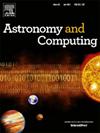商用超级计算机在射电天文数据处理中的经验
IF 1.8
4区 物理与天体物理
Q2 ASTRONOMY & ASTROPHYSICS
引用次数: 0
摘要
计算能力的持续指数级增长,以及商业高性能计算(HPC)行业的增长,已经导致10个商业系统目前超过了澳大利亚射电天文学中使用率最高的HPC系统的性能,其中一个超过了平方公里阵列(SKA)科学数据处理器的预期要求。为了探索射电天文学中HPC领域这一新兴变化的影响,我们报告了一项调查的结果,该调查通过半结构化访谈对14位在天文学和类似数据密集型领域具有商业HPC经验的澳大利亚科学家和供应商进行了调查。我们用两项早期研究的经验补充了这些数据,在这两项研究中,我们调查了商业高性能计算在射电天文学数据处理中的应用,使用了非常不同的数据和处理考虑。我们使用主题分析的定性研究方法从访谈中提取关键信息。我们发现商业高性能计算在可及性和可用性方面具有主要优势,并可能有助于提高研究人员的职业生产力。然而,存在着重大的障碍,包括需要获得更多的系统编程和并行化方面的专门知识,以及需要在研究经费方面得到认可。我们对这些问题的可能解决办法发表评论。本文章由计算机程序翻译,如有差异,请以英文原文为准。
Experiences of commercial supercomputing in radio astronomy data processing
The ongoing exponential growth of computational power, and the growth of the commercial High Performance Computing (HPC) industry, has led to a point where ten commercial systems currently exceed the performance of the highest-used HPC system in radio astronomy in Australia, and one of these exceeds the expected requirements of the Square Kilometre Array (SKA) Science Data Processors.
In order to explore implications of this emerging change in the HPC landscape for radio astronomy, we report results from a survey conducted via semi-structured interviews with 14 Australian scientists and providers with experience of commercial HPC in astronomy and similar data intensive fields. We supplement these data with learnings from two earlier studies in which we investigated the application of commercial HPC to radio astronomy data processing, using cases with very different data and processing considerations.
We use the established qualitative research approach of thematic analysis to extract key messages from our interviews. We find that commercial HPC can provide major advantages in accessibility and availability, and may contribute to increasing researchers’ career productivity. Significant barriers exist, however, including the need for access to increased expertise in systems programming and parallelization, and a need for recognition in research funding. We comment on potential solutions to these issues.
求助全文
通过发布文献求助,成功后即可免费获取论文全文。
去求助
来源期刊

Astronomy and Computing
ASTRONOMY & ASTROPHYSICSCOMPUTER SCIENCE,-COMPUTER SCIENCE, INTERDISCIPLINARY APPLICATIONS
CiteScore
4.10
自引率
8.00%
发文量
67
期刊介绍:
Astronomy and Computing is a peer-reviewed journal that focuses on the broad area between astronomy, computer science and information technology. The journal aims to publish the work of scientists and (software) engineers in all aspects of astronomical computing, including the collection, analysis, reduction, visualisation, preservation and dissemination of data, and the development of astronomical software and simulations. The journal covers applications for academic computer science techniques to astronomy, as well as novel applications of information technologies within astronomy.
 求助内容:
求助内容: 应助结果提醒方式:
应助结果提醒方式:


